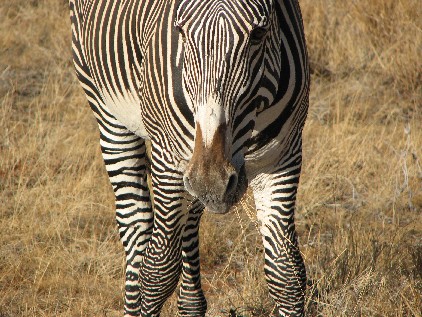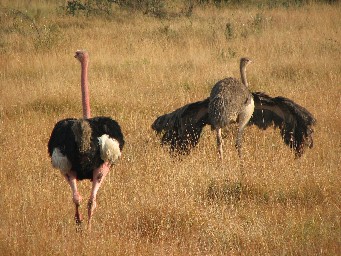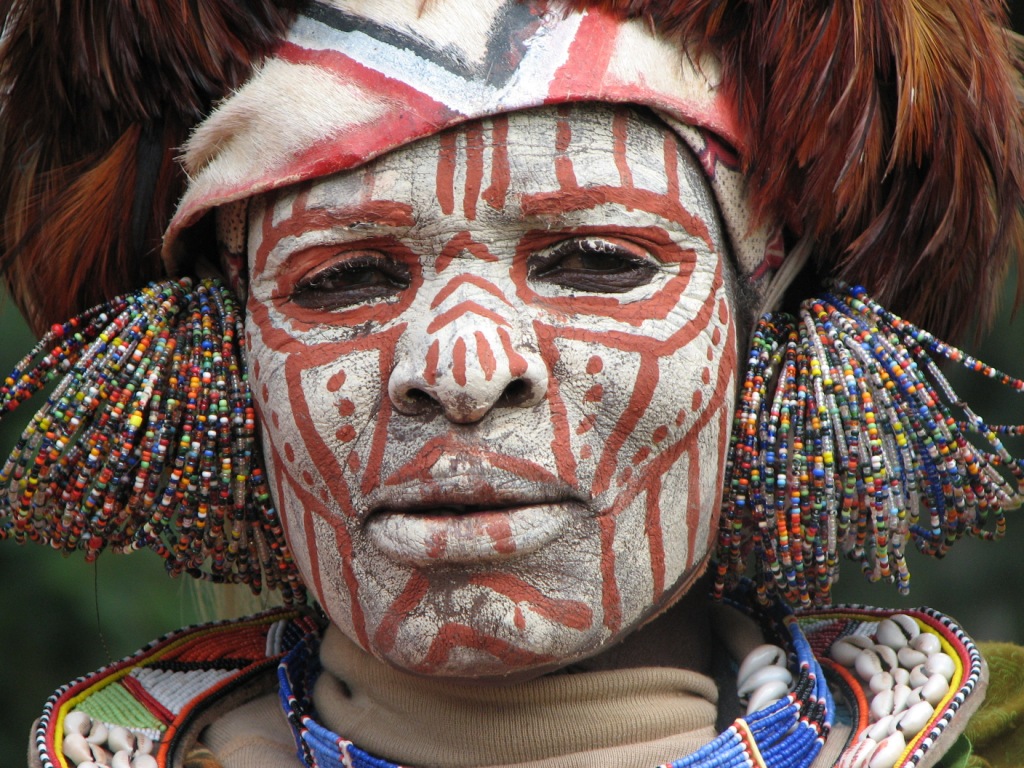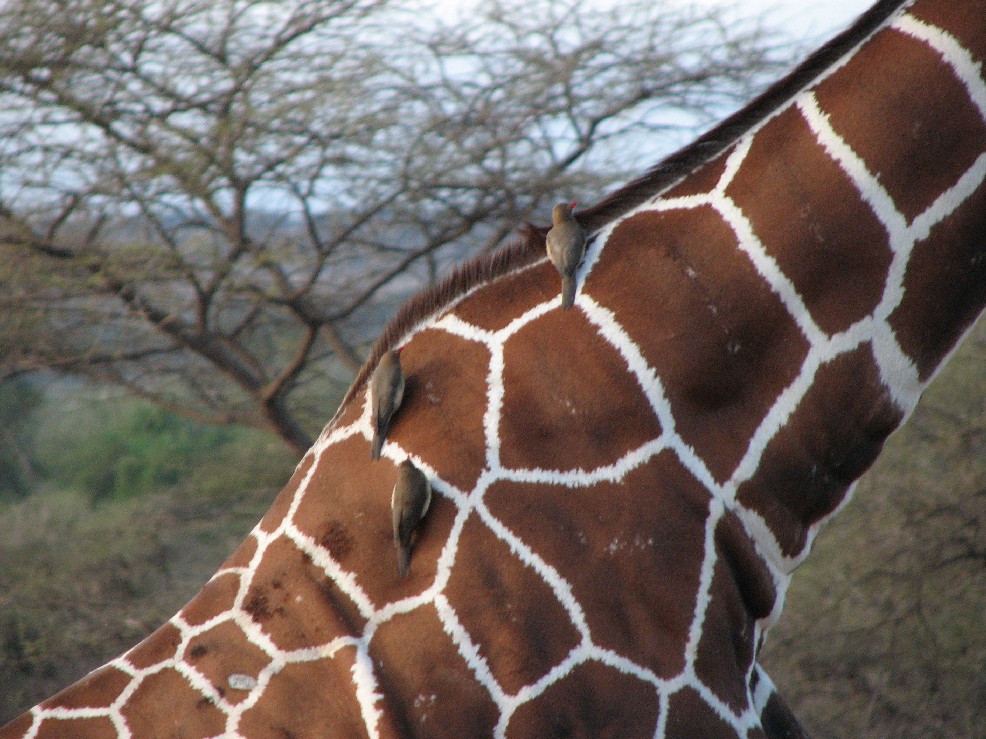So the blog is a bit out of order, but my fond  memories of Lake Nakuru National Park have made me jump a bit in the chronological order of our safari. So Lake Nakuru NP is a soda lake, meaning it has alkaline waters, which nourishes the both blue-green algae and a particular group of crustaceans. Now if you are not impressed yet with the lake's greenish slug the two particular animals after this rather interesting mix is the greater and lesser flamingos. There are not just a few flamingos but rather tens of thousands, at any given time, like lawn ornaments gone hostel guarding the lake. Well, okay they don't guard so well and you can easily set a hundred a flight by approaching to closely.
memories of Lake Nakuru National Park have made me jump a bit in the chronological order of our safari. So Lake Nakuru NP is a soda lake, meaning it has alkaline waters, which nourishes the both blue-green algae and a particular group of crustaceans. Now if you are not impressed yet with the lake's greenish slug the two particular animals after this rather interesting mix is the greater and lesser flamingos. There are not just a few flamingos but rather tens of thousands, at any given time, like lawn ornaments gone hostel guarding the lake. Well, okay they don't guard so well and you can easily set a hundred a flight by approaching to closely.
 memories of Lake Nakuru National Park have made me jump a bit in the chronological order of our safari. So Lake Nakuru NP is a soda lake, meaning it has alkaline waters, which nourishes the both blue-green algae and a particular group of crustaceans. Now if you are not impressed yet with the lake's greenish slug the two particular animals after this rather interesting mix is the greater and lesser flamingos. There are not just a few flamingos but rather tens of thousands, at any given time, like lawn ornaments gone hostel guarding the lake. Well, okay they don't guard so well and you can easily set a hundred a flight by approaching to closely.
memories of Lake Nakuru National Park have made me jump a bit in the chronological order of our safari. So Lake Nakuru NP is a soda lake, meaning it has alkaline waters, which nourishes the both blue-green algae and a particular group of crustaceans. Now if you are not impressed yet with the lake's greenish slug the two particular animals after this rather interesting mix is the greater and lesser flamingos. There are not just a few flamingos but rather tens of thousands, at any given time, like lawn ornaments gone hostel guarding the lake. Well, okay they don't guard so well and you can easily set a hundred a flight by approaching to closely. We only had half a day in this park, which is much smaller than the Maasai Mara but I felt I could have spent days. The park also boast some rather lazy white rhinos, which were reintroduced many years ago, and some rare tree climbing lions. We actually saw the lions, about six, including a cub in the trees sleeping as we left the park. The park also has it share of Africana icons: giraffes (although a different subspecies), warthogs, cape buffalo, baboons, waterbuck, gazelle and the like. We actually saw in great number here one the smallest of the antelope species, Kirk's Dik Dik. Name aside it is a delicate little creature and looks more like something out of fiction book with its funny little nose and unimposing horns. For anyone a fan of miniatures... this is your antelope.
could have spent days. The park also boast some rather lazy white rhinos, which were reintroduced many years ago, and some rare tree climbing lions. We actually saw the lions, about six, including a cub in the trees sleeping as we left the park. The park also has it share of Africana icons: giraffes (although a different subspecies), warthogs, cape buffalo, baboons, waterbuck, gazelle and the like. We actually saw in great number here one the smallest of the antelope species, Kirk's Dik Dik. Name aside it is a delicate little creature and looks more like something out of fiction book with its funny little nose and unimposing horns. For anyone a fan of miniatures... this is your antelope.
 could have spent days. The park also boast some rather lazy white rhinos, which were reintroduced many years ago, and some rare tree climbing lions. We actually saw the lions, about six, including a cub in the trees sleeping as we left the park. The park also has it share of Africana icons: giraffes (although a different subspecies), warthogs, cape buffalo, baboons, waterbuck, gazelle and the like. We actually saw in great number here one the smallest of the antelope species, Kirk's Dik Dik. Name aside it is a delicate little creature and looks more like something out of fiction book with its funny little nose and unimposing horns. For anyone a fan of miniatures... this is your antelope.
could have spent days. The park also boast some rather lazy white rhinos, which were reintroduced many years ago, and some rare tree climbing lions. We actually saw the lions, about six, including a cub in the trees sleeping as we left the park. The park also has it share of Africana icons: giraffes (although a different subspecies), warthogs, cape buffalo, baboons, waterbuck, gazelle and the like. We actually saw in great number here one the smallest of the antelope species, Kirk's Dik Dik. Name aside it is a delicate little creature and looks more like something out of fiction book with its funny little nose and unimposing horns. For anyone a fan of miniatures... this is your antelope. So when we first arrived at the lake we were a bit lucky, only a couple vans with Japanese tourist all of which had cameras and lenses that made me flush green with envy. Ben immediately took up the bird watching campaign as there is more than the hoard of flamingos in the park and I wondered off along the edge of the lake and peered into the sea of pink. My lens-envy aside no digital or analogue apparatus could render this lake as beautiful as it was there in full panorama, surround sound and the pungent smell of bird in the air. Ben and I had to be hauled back in the vehicle for a drive up to the Baboon Cliff lookout. The drive was pleasant because we had beaten the large drove of vehicle that were just now pulling up to spoil all the Japanese photographers. Our lone vehicle pulled up to a spotted hyaena munching down on something a Marabou Stork voraciously looking on for scraps. Was that a pink feather I saw?
So when we first arrived at the lake we were a bit lucky, only a couple vans with Japanese tourist all of which had cameras and lenses that made me flush green with envy. Ben immediately took up the bird watching campaign as there is more than the hoard of flamingos in the park and I wondered off along the edge of the lake and peered into the sea of pink. My lens-envy aside no digital or analogue apparatus could render this lake as beautiful as it was there in full panorama, surround sound and the pungent smell of bird in the air. Ben and I had to be hauled back in the vehicle for a drive up to the Baboon Cliff lookout. The drive was pleasant because we had beaten the large drove of vehicle that were just now pulling up to spoil all the Japanese photographers. Our lone vehicle pulled up to a spotted hyaena munching down on something a Marabou Stork voraciously looking on for scraps. Was that a pink feather I saw? The question was quickly answered as we spot another hyaena running confidently but with not too much haste into a crowd of flamingos. Our driver said they often do that and look for the ones unable to take flight. So there we were less than 100 yards from the hunt and we watched how the hyaena turned, reassessed and rather easily came out of the shallows of the lake with a bright pink prey in his mouth. Okay so some of you don't enjoy nature's carnage but these displays are the best in terms of wildlife viewing. That life ya know... birds gotta fly and hyaenas gotta eat. Maybe we could change the phrase from "Like a sitting duck," to "Like an elegantly standing flamingo?" Doesn't have the same ring.
The question was quickly answered as we spot another hyaena running confidently but with not too much haste into a crowd of flamingos. Our driver said they often do that and look for the ones unable to take flight. So there we were less than 100 yards from the hunt and we watched how the hyaena turned, reassessed and rather easily came out of the shallows of the lake with a bright pink prey in his mouth. Okay so some of you don't enjoy nature's carnage but these displays are the best in terms of wildlife viewing. That life ya know... birds gotta fly and hyaenas gotta eat. Maybe we could change the phrase from "Like a sitting duck," to "Like an elegantly standing flamingo?" Doesn't have the same ring.We headed up to Baboon Cliff and kept our eyes unsuccessfully pealed for a leopard. The view from the top was simply amazing. You see the lake below, the flamingos look like a mirage of pink in the distance, with the occasional cape buffalo or rhino dreamily strolling along the waters edge. Ben and I wanted to see a Rock Hyrax, which is a small ungulate (stomach like a cow) that actually looks like an overgrown ginea pig, and we found a small den, the rather pungent evidence of their inhabitation left in neat pellet like piles by their front entrance, but no Hyrax.
from the top was simply amazing. You see the lake below, the flamingos look like a mirage of pink in the distance, with the occasional cape buffalo or rhino dreamily strolling along the waters edge. Ben and I wanted to see a Rock Hyrax, which is a small ungulate (stomach like a cow) that actually looks like an overgrown ginea pig, and we found a small den, the rather pungent evidence of their inhabitation left in neat pellet like piles by their front entrance, but no Hyrax.
 from the top was simply amazing. You see the lake below, the flamingos look like a mirage of pink in the distance, with the occasional cape buffalo or rhino dreamily strolling along the waters edge. Ben and I wanted to see a Rock Hyrax, which is a small ungulate (stomach like a cow) that actually looks like an overgrown ginea pig, and we found a small den, the rather pungent evidence of their inhabitation left in neat pellet like piles by their front entrance, but no Hyrax.
from the top was simply amazing. You see the lake below, the flamingos look like a mirage of pink in the distance, with the occasional cape buffalo or rhino dreamily strolling along the waters edge. Ben and I wanted to see a Rock Hyrax, which is a small ungulate (stomach like a cow) that actually looks like an overgrown ginea pig, and we found a small den, the rather pungent evidence of their inhabitation left in neat pellet like piles by their front entrance, but no Hyrax. Well the park's history, like many in East Africa is all pink and furry like we would all like to believe. The park covers about 180 square kilometers and since its creation in 1961 has experienced multiple crashes and recoveries in the flamingo population due to the erratic water levels in the lake. The parks 1st birthday was actually sullied by the fact that the lake completely dried up! And heavy rains which diluted the alkalinity also caused another flamingo crash and  mass exodus in the 1970s. More recent management woes have been pollution from Nakuru town, pesticide runoff from the matrix of farms in the area and large scale deforestation in the surrounding watershed. The World Wildlife Fund (WWF) has stepped in with efforts to combat these modern day realities, particularly by the replanting of saplings in the watershed. Like everything though, the wild corners left will depend as much or more on managing people as the wildlife itself.
mass exodus in the 1970s. More recent management woes have been pollution from Nakuru town, pesticide runoff from the matrix of farms in the area and large scale deforestation in the surrounding watershed. The World Wildlife Fund (WWF) has stepped in with efforts to combat these modern day realities, particularly by the replanting of saplings in the watershed. Like everything though, the wild corners left will depend as much or more on managing people as the wildlife itself.
 mass exodus in the 1970s. More recent management woes have been pollution from Nakuru town, pesticide runoff from the matrix of farms in the area and large scale deforestation in the surrounding watershed. The World Wildlife Fund (WWF) has stepped in with efforts to combat these modern day realities, particularly by the replanting of saplings in the watershed. Like everything though, the wild corners left will depend as much or more on managing people as the wildlife itself.
mass exodus in the 1970s. More recent management woes have been pollution from Nakuru town, pesticide runoff from the matrix of farms in the area and large scale deforestation in the surrounding watershed. The World Wildlife Fund (WWF) has stepped in with efforts to combat these modern day realities, particularly by the replanting of saplings in the watershed. Like everything though, the wild corners left will depend as much or more on managing people as the wildlife itself. Ben and I left, our necks straining to get the last looks at the park. Although I have long had an aversion of pink, with all its gender-heavy hues, I must admit Lake Nakuru really makes pink look good.
-Jessica













No comments:
Post a Comment